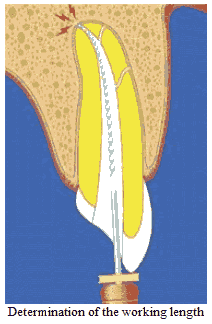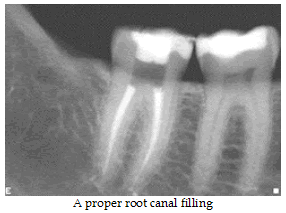The easy root canal!
Everyone had some trouble with root canal therapy. Sometimes it went bad, had to redo the root canal, or worse lost your tooth… Well today you can forget about those problems. Now root canal therapy is easy, it only takes 50 minutes even for a molar tooth to get done, everything is done mechanically, no hustle, no fuss, and no pain. Pictures of before and after
Detailed information about the easy root canal.
More or less every one of us has heard of root canal therapy.
The proper term is therapy treatment of a tooth’s root canals in order to remove the nerves and the remaining debris from the tooth. Or to put it simply it is just a procedure that removes the “aching” nerve.
But what is the reason for all this? Why is this happening to our teeth?
There are many ways leading to a root canal therapy. The most common is pulpitis.
Pulpitis is a nerve disease where the nerve responds to all kinds of irritations (cold and hot) and as a result the tooth aches in order for us to understand that something is going wrong.

Caries and trauma are the most common reasons for pulp exposure.
The mechanism is rather simple, through the caries cavity or the trauma a path is open to the pulp. Therefore the tooth is no longer sealed to infectious bacteria that live in our mouth. The result is inflammation. When the pulp becomes inflamed pressure begins to build up in the pulp cavity exerting pressure on the nerve of the tooth and the surrounding tissues. Pressure from inflammation can cause mild to extreme pain, depending upon the severity of the inflammation. Often, pulpitis can create so much pressure on the tooth nerve the individual will have trouble locating the source of the pain, confusing it with neighboring teeth.
So, trauma and caries are the most common reasons for a root canal therapy, but not the only ones. Sometimes a dentist performs root canal therapies to teeth that will be included in a bridge or a crown.
You see when a tooth will be prepared for a crown/bridge a large amount of tissues is retracted from the tooth and the pulp chamber is either already open or really close to that and therefore even though the tooth is covered by a crown/bridge, several times it can provide pain.
The root canal seems so complicated but things are not as confusing as they seem at first. The dentist has to make an x-ray of the tooth in order to study the tooth’s anatomy. Then it’s time for some anesthesia in order to make sure there will be no pain whatsoever.
From this point on, the patient does not feel any pain.
The dentist creates a path to the pulp and removes the nerve from the root canal. The next step in the root canal therapy is to get a precise measurement of the root canal’s length so the dentist can work at the proper length and not overdue the preparation by getting out of the tooth’s root (that means out to the bone) or less than the end of the root leaving a lot of space to bacteria.
There are several ways to measure a tooth’s root:
1. With an x-ray. The dentist inserts in the root an instrument up to the point where he thinks that he has reached the end of the root.
2. With a paper point. If the dentist has reached the end of the root, the paper point’s end has a small red blood mark on it.
3. By touch. Some dentists claim that they “feel” the end of the root.
4. Using a special device called – apex locator.
But one cannot rely only on one of those methods to be sure that he has made the preparation of the root thoroughly until the end (the apex). The working length (meaning the full root length) must be confirmed at least with three of these methods.

Since we have already determined the working length the dentist proceeds to proper and thorough cleaning and disinfection of the root canal.
This is one of the most important issues in a root canal therapy. Every root canal must be thoroughly cleaned and disinfected from start to end, with the creation of a conical path to the apex and finally sealed three dimensionally (meaning really tight) with the proper filling material.
There are several ways to clean a root canal. You can do it manually or mechanically. Both are equally good.
Nowadays the mechanical approach is the most common one, since it is more practical – it uses a certain protocol creating a conical root canal that is easier to fill – and faster which is good for the dentist since he is saving time and for the patient since he is going to receive a less time consuming treatment.
The final step in root canal therapy is the filling of the root canal with a proper filling material. After that the tooth is sealed with a temporary restoration and the dentist makes another x-ray to make sure that everything is in order. Sometimes if everything is proceeding normally, dentists make a permanent filling straight away. Otherwise the permanent filling is done in the next appointment.

Many people are wondering why they should do a root canal therapy?
“So what is the big deal if I don’t do a root canal? The pain will go away sometime!”
The truth is a lot different though. Yes it is true that the pain will pass in a few days, or maybe a week, but that does not mean that the reason for that pain goes away.
The pain gradually stops but it will come back from time to time. Is that not good? The answer is no.
It is not good because from a simple pulpitis we can go to more complicated stuff and most of the time the result is a well sized cyst and the treatment from that point on is becoming not only more complicated and costly, but sometimes teeth with rather large cysts have to be extracted.
So why go into all this trouble, leave your tooth untreated and full of bacteria, tolerate all this pain and spend a bund load of money for all these treatments, when you can just do a simple root canal therapy and save a lot more money?
Today root canal therapy is fast and painless.
One popular idea is to have your root canal therapy done before, after or during your holidays in Greece or the Greek islands.
If you would like to know more about root canal therapy please contact one of our listed root canal therapy dentists in Greece.
